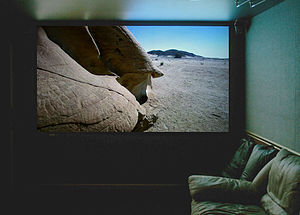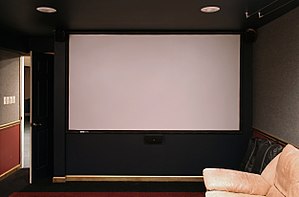Home cinema

Home cinema, also called home theatre, seeks to reproduce cinema quality video and audio in the home. The video aspect usually involves a large-screen and/or high definition television or a projection system with movie screen to project the image on. Quality audio reproduction is usually achieved with a high fidelity surround sound system.
Technically, a home cinema could be as basic as a simple arrangement of a television, VCR, DVD, and a set of speakers. It is therefore difficult to specify exactly what distinguishes a "home cinema" from a "television and stereo". Most people in the consumer electronics industry would agree that a "home theater" is really the integration of a relatively high-quality video source with multi-channel electronics and speakers. Even if households have the system set up for home cinema it is common only to use the speakers integrated within the television rather than to play the sound through the surround sound system. This is because surround sound loses its impact with material which is not recorded in a way suitable for surround sound. Films, drama and sports tend to be optimised for surround sound whereas news and daytime TV provide no particular advantage.
History
1950s and 1960s home movies

In the 1950s, home movies became popular in the United States and elsewhere as Kodak 8 mm film (Pathé 9.5 mm in France) and camera and projector equipment became affordable. Projected with a small, portable movie projector onto a portable screen, often without sound, this system became the first practical home theater. They were generally used to show home movies of family travels and celebrations but also doubled as a means of showing private stag films. Dedicated home cinemas were called screening rooms at the time and were outfitted with 16 mm or even 35 mm projectors for showing commercial films. These were found almost exclusively in the homes of the very wealthy, especially those in the movie industry.
Portable home cinemas improved over time with color film, Kodak Super 8 mm film film cartridges, and monaural sound but remained awkward and somewhat expensive. The rise of home video in the late 1970s almost completely killed the consumer market for 8 mm film cameras and projectors, as VCRs connected to ordinary televisions provided a simpler and more flexible substitute.
1980s home cinema
The development of multi-channel audio systems and laserdisc in the 1980s created a new paradigm for home cinema. The first known home cinema system was installed as a sales tool by Steve LaFontaine at Kirshmans furniture store 5800 veterans memorial hwy. in metairie louisiana in 1974 where he built a special sound room which incorporated the earliest quadraphonic audio systems with his video projection systems he invented and hand built by modifying Sony trinitron televisions for projecting the image. Many systems were sold in the New Orleans area in the unsuing years before the first public demonstration of this integration occurred in 1982 at the Summer Consumer Electronics Show in Chicago, Illinois. Peter Tribeman of NAD (USA) organized and presented a demonstration made possible by the collaborative effort of several companies who contributed their technologies to demonstrate what a home cinema would "look and sound" like.
Over the course of three days, retailers, manufacturers, and members of the consumer electronics press were exposed to the first "home like" experience of combining a high quality video source with multi-channel sound. That one demonstration is credited with being the impetus for developing what is now a multi-billion dollar business.
1990s home cinema
In the late 1990s, the development of DVD, 5-channel audio, and high-quality video projectors that provide a cinema experience at a price that rivals a big-screen HDTVs sparked a new wave of home cinema interest.
Design
Today, "home cinema" implies a real "cinema experience" and therefore a higher quality set of components than the average television provides. A typical home theater would include the following:
- A large, high-quality, display - generally a big-screen television (Liquid crystal display television, plasma TV, traditional CRT TV, or a rear-projection TV) or possibly a video projector, often HDTV-capable.
- One or more audio/video sources. High quality formats such as DVD or laserdisc are preferred, though old home cinema setups use a stereo VHS VCR. Cable, KU or C band are also common. The exponential increase in the capacity of hard disk drives and the processing power of home computers has made it possible to buy or build a home theater PC to act as a library for video and music content. Recently, HD DVD and Blu-Ray players, each capable of outputting high definition pictures at up to 1080p and high quality sound, have become available, and one or other of these formats is expected to displace DVD as the high end consumer format of choice.
- An audio system that is capable of surround sound. This usually consists of at least 4 (though more are common) full range speakers and a subwoofer for low frequency effects. Sometimes a specialized decoder is used to allow the playback of newer surround-sound formats.
- Comfortable seating and organization to improve the cinema feel. This might include several comfortable recliners and curtains or subdued room lighting (required for video projectors) to enhance the experience.
- Higher end home theaters commonly also have sound insulation to prevent noise from escaping the room, and a specialized coating to ensure correct absorption of the sound in the room.

Dedicated home theaters
Some home cinema enthusiasts go so far as to build a dedicated room in the home for the theater. Such a room is often decorated to resemble an actual cinema, with projection enclosed in a projection booth, specialized furniture, a piano or theatre organ, curtains in front of the projection screen, movie posters, or a popcorn or snack machine. These more advanced installations often include sophisticated acoustic design elements, including "room-in-a-room" construction that isolates sound and provides the potential for a nearly ideal listening environment. These installations are often designated as "screening rooms" to differentiate from simpler installations.
A few home cinema setups even have features that are not commonly found in commercial cinemas, such as tactile sound. Others go to extremes in design such as the Death Star Designed Home Theater.
Component systems vs. theater-in-a-box
High-quality home cinemas are assembled from component pieces purchased separately to provide the best combination of equipment for the cost. It is possible to purchase home theater in a box kits that include a set of speakers for surround sound, an amplifier/tuner for adjusting volume and selecting video sources, and sometimes a DVD player. Though these kits pale in comparison to a custom-built home cinema, they are inexpensive and easy to set up; one needs only to add a television and some movies in order to create a simple home theater.
Because the difficulty of running long cables through walls for surround sound inhibits some consumers, some home cinemas includes wireless rear loudspeakers, with in-built amplifiers.

Connections
There is a broad variety of connections generally included in home cinema to enable the different components to work together or to be integrated with computers or other electronic equipment. Some are relatively inexpensive, such as S-video, while some actually enable the high quality picture viewing, such as HDMI. In addition to wired connections, there are also wireless connection. while it may be used to transmit large volume of data (such as sound) to ease set ups, usually it is relegate to remote control applications. Some may even use digital wireless data standards such as Bluetooth, which is currently used by the remote of Playstation 3, an example of an Blue Ray Disk player.
Backyard theater
In places that have proper outdoor elements and is legal to do, it is also common for people to set up their home theatre in their backyard. Depending on the space available, it may simply be a temporary version with foldable screens, a projector and 2 speakers, or a permanent fixture of frame-mounted 15 feet screens set up by the poolside. Some backyard theaters even feature refurbished car chassis and speaker posts, mimicing the feel of drive-in theater.[1] [2]
Due to the outdoor nature, it is quite popular with BBQ parties and pool parties.
Some people have built on the idea, and built mobile drive-in theaters that can play movies in public open space. Usually, these will require a powerful projector, a source (laptop or DVD player), outdoor speakers, and/or FM transmitter to broadcast audio signal to other car radios. [3] [4]
See also
- AV Receivers
- bluetooth
- CD recording
- Dolby Digital, DTS
- Domotics
- DVD
- Haas Effect
- HiFi
- Home theater PC
- Jack (connector)
- Liquid crystal display television
- Matrix decoder
- Subwoofer
External links
- Learn About Home Theater @ LSO: Home Theater Methodology
- Articles on how to increase the performance of your home theater system.
- Home Theater design articles
